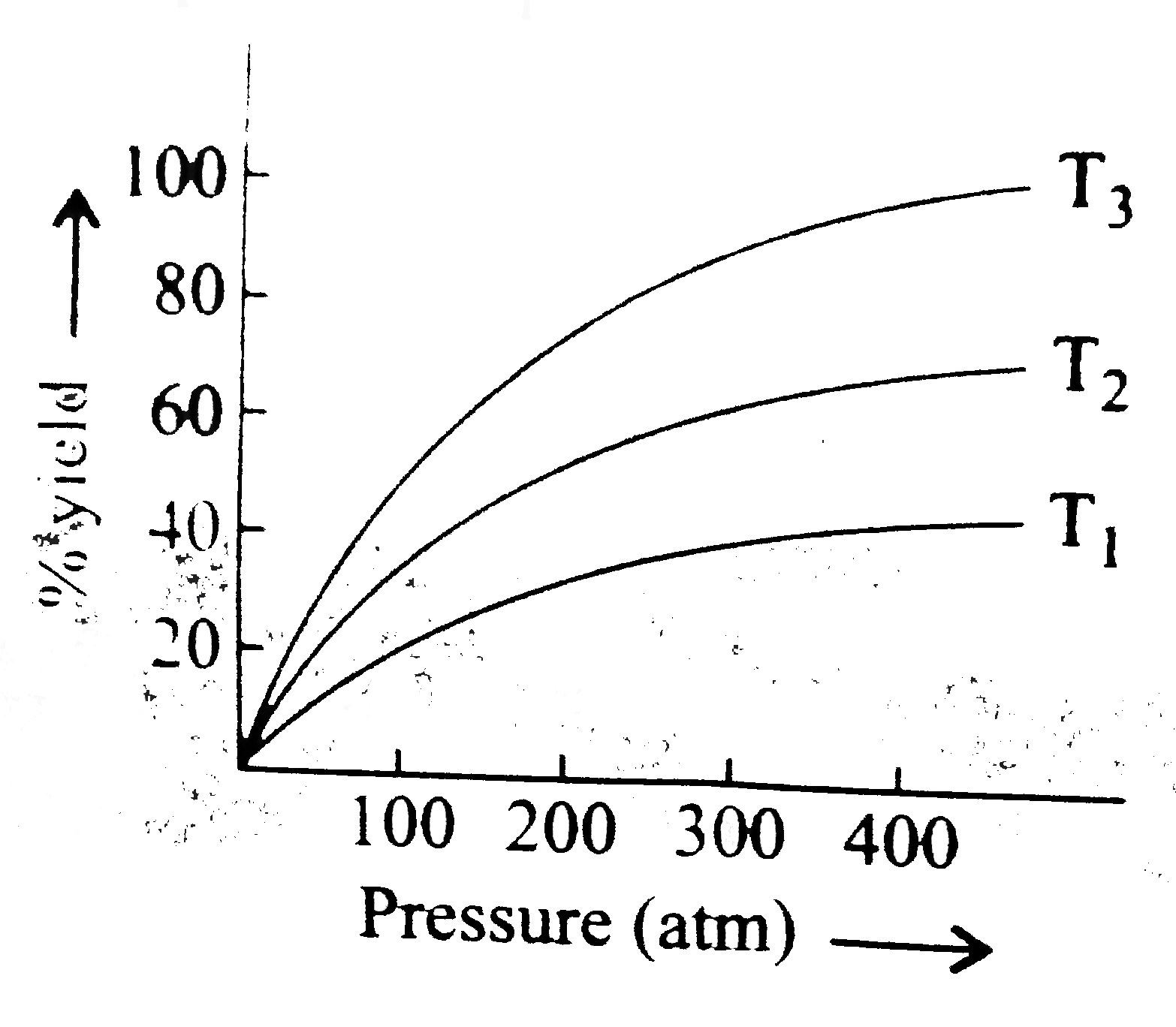The formation of ammonia by Haber's process is favoured by ………. pressure.
To determine the pressure conditions that favor the formation of ammonia in the Haber process, we can follow these steps:
1. Understand the Haber Process: The Haber process involves the reaction of nitrogen gas (N₂) and hydrogen gas (H₂) to form ammonia (NH₃). The balanced chemical equation for this reaction is:
N2(g)+3H2(g)⇌2NH3(g)
2. Identify the Moles of Gases: In this reaction, we have:
- Reactants: 1 mole of N₂ + 3 moles of H₂ = 4 moles of gaseous reactants
- Products: 2 moles of NH₃
3. Apply Le Chatelier's Principle: According to Le Chatelier's principle, if a system at equilibrium is subjected to a change in pressure, the equilibrium will shift in the direction that reduces the pressure. This means that if we increase the pressure, the reaction will favor the side with fewer moles of gas.
4. Determine the Effect of Pressure: Since there are 4 moles of gas on the reactant side and only 2 moles of gas on the product side, increasing the pressure will favor the formation of ammonia (NH₃), as it results in a decrease in the total number of gas moles.
5. Conclusion: Therefore, the formation of ammonia by the Haber process is favored by high pressure.
Final Answer:
The formation of ammonia by Haber’s process is favored by high pressure.
---
N2(g)+3H2(g)⇌2NH3(g)
- Reactants: 1 mole of N₂ + 3 moles of H₂ = 4 moles of gaseous reactants
- Products: 2 moles of NH₃
The formation of ammonia by Haber’s process is favored by high pressure.
Topper's Solved these Questions
- CHEMICAL EQUILIBRIUMBook:CENGAGE CHEMISTRY ENGLISHChapter:CHEMICAL EQUILIBRIUMExercise:Exercises (True/False)
Explore 30 Videos
- CHEMICAL EQUILIBRIUMBook:CENGAGE CHEMISTRY ENGLISHChapter:CHEMICAL EQUILIBRIUMExercise:Archives (Multiple Correct)
Explore 6 Videos
- CHEMICAL EQUILIBRIUMBook:CENGAGE CHEMISTRY ENGLISHChapter:CHEMICAL EQUILIBRIUMExercise:Exercises (Integer)
Explore 7 Videos
- CHEMICAL BONDING AND MOLECULAR STRUCTUREBook:CENGAGE CHEMISTRY ENGLISHChapter:CHEMICAL BONDING AND MOLECULAR STRUCTUREExercise:Archives Subjective
Explore 15 Videos
- CLASSIFICATION AND NOMENCLATURE OF ORGANIC COMPOUNDSBook:CENGAGE CHEMISTRY ENGLISHChapter:CLASSIFICATION AND NOMENCLATURE OF ORGANIC COMPOUNDSExercise:Analytical and Descriptive Type
Explore 3 Videos
Similar Questions
The formation of anion from a neutral atom X is favoured by:
View SolutionN2(g)+3H2(g)⇔2NH3(g),ΔHɵ=−22.4kJ
The pressure inside the chamber is 100 atm and temperature at 300K
The preparation of ammonia by Haber's process is an exothermic reaction. If the preparation follows the following temperature-pressure relationship for its % yield. Then for temperature T1,T2 and T3 the correct option is:

View SolutionMatch the following :
List-IList_II(P)Formation of ammonia by haber's process<br>(1)increase in temperature(Q)Formation ofSO3in contact process for manufacture of H2SO4(2)Decrease in temperature(R)Formation of NO in Birk-land Eyde process for manufacture of HNO3(3)Decrease in pressure(S)Formation ofNO2(g)by following reactionNO(g)+O3⇔NO2(g)+O2(g)+200KJ(4)increase in pressure
View SolutionIn the industrial preparation of ammonia by Haber process from nitrogen and hydrogen, the reaction is carried in the temperature range of 450∘C to 500∘C and in a pressure range of 200 atm to 300 atm. Now answer the following question.
How is ammonia separated from unreacted nitrogen and hydrogen?
View SolutionIn the industrial preparation of ammonia by Haber process from nitrogen and hydrogen, the reaction is carried in the temperature range of 450∘C to 500∘C and in a pressure range of 200 atm to 300 atm. Now answer the following question.
The reaction is not carried at very high pressure. Give one reason.
View SolutionIn the industrial preparation of ammonia by Haber process from nitrogen and hydrogen, the reaction is carried in the temperature range of 450∘C to 500∘C and in a pressure range of 200 atm to 300 atm. Now answer the following question.
The reaction is not carried out at a lower temperature. Give one reason.
View SolutionIn the industrial preparation of ammonia by Haber process from nitrogen and hydrogen, the reaction is carried in the temperature range of 450∘C to 500∘C and in a pressure range of 200 atm to 300 atm. Now answer the following question.
What is the name of the catalyst used in the reaction?
View SolutionDuring synthesis of ammonia by Haber's process,
'CO' acts is
View SolutionExplain why high pressure is used in the manufacture of ammonia by Haber's process. State the law or principle used.∗∗
View SolutionIndustrially, ammonia is obtained by direct combination between nitrogen and hydrogen.
Is the formation of ammonia promoted by the use of high pressure or low pressure?
View Solution